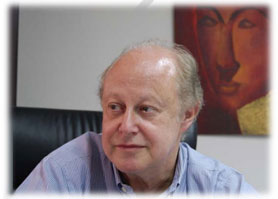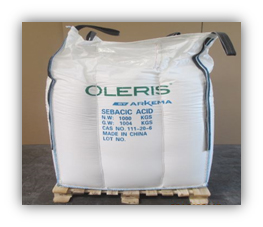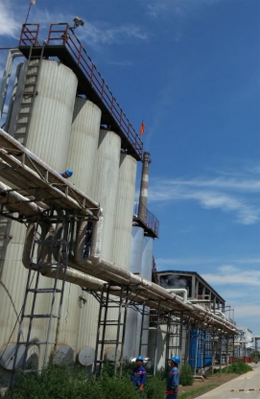Sebacic Acid — a unique, bio-based feedstock for green polymers:
Interview with Roland Glotzer
Bio-based polymers are produced using renewable resources and appear to be more environmentally friendly than polymers derived from petroleum. Owing to their ecological benefits, bio-based polymers are gaining acceptance and both production and consumption of bio-based polymers are on the rise. Polyamide, also known as nylon, is a dominant engineering plastic with applications in various industries such as automotive, electronics, construction and consumer goods. Bio-based polyamide is commercially available since more than 40 years and is the oldest bio-based engineering plastic. Most of the bio-based polyamides today are derived from castor oil. The key ingredient in castor oil for polyamides use is sebacic acid, which is a dicarboxylic acid with the structure (HOOC)(CH2)8(COOH) and is supplied as white granules or powdered crystals. Ninety five percent of the global supply of sebacic acid comes from China with small production in India and Japan.
In 2012, Arkema, the France-based chemical company and a global leader in the production of bio-based polyamides, acquired Casda Biomaterials, the earliest manufacturer of sebacic acid in China. Roland Glotzer, who previously headed Arkema Chemicals India, took control as the CEO of Casda Biomaterials in August 2014.
In an interview with Lekhraj Ghai of POLYMERUPDATE, Roland Glotzer provides an in-depth understanding of the global sebacic acid business: its strengths, challenges and outlook.

Roland Glotzer
Interview of Roland Glotzer (RG) with Lekhraj Ghai (LG):
LG: What are the advantages of bio-based polymers that are made from sebacic acid?
RG: Sebacic acid derived from castor oil is a very unique chemical with a wide diversity of applications and performance benefits. It is used in the production of bio-polyamides where it imparts important properties like excellent flexibility, durability, hydrophobicity and lower melting temperatures. Sebacic acid is also used in polyesters where its good flexibility, chemical resistance, stability and solvent resistance make it an excellent dibasic acid. These polyesters are used in various coating applications such as coils and architectural and high solids paints.
LG: How cost-competitive is sebacic acid to other raw materials for polyamides, say, caprolactam?
RG: Pricing of products is affected to a large extent by feedstock costs. Castor oil, the key raw material for producing sebacic acid, was short and extremely costly in 2011 but has since eroded while caprolactam is a petroleum derivative benefiting at present from the unexpectedly low crude oil prices. However, we know that crude oil is a finite resource and castor oil is a renewable resource so the long-term trend should logically be for synthetic materials to progressively lose some of the economic advantages they may currently have. In today's market where sebacic acid sells in the range USD 3,550 to USD 3,700 per ton FOB China and caprolactam at around USD 2,700 per ton, it is clear that sebacic acid based polyamides are costlier. On the other hand, polyamides based on sebacic acid offer better physical and chemical properties, such as better flexibility and hydrophobicity. So, the selection of sebacic acid as feedstock is based much more on performance requirements than on cost.
LG: Tell us about the use of sebacic acid derivatives in plasticizers. How does the addition of these plasticizers in resins affect the biodegradability of vinyl compounds that are produced from them?
RG: Plasticizers are one of the applications where esters based on sebacic acid are used; another major use being in light stabilizers. The main reason to use plasticizers based on sebacates, i.e., esters of sebacic acid, is because of their superior low temperature resistance compared to phthalate plasticizers. Sebacates such as dibutyl sebacate (DBS) also impart resistance to migration and sulphur staining, which explains their wide use as plasticizer in food packaging. Dimethyl sebacate (DMS) is used in light stabilizers for cellulose resins, synthetic resins and rubbers.

LG: Tell us more about the Casda Biomaterials manufacturing facility in Hengshui, China. What are the products offered in addition to sebacic acid? How much of the installed capacity is being utilized?

Casda Biomaterials manufacturing facility in Hengshui, Hebei, China
RG: Sebacic acid is the single most important product manufactured at the Hengshui site in Hebei. We do however differentiate ourselves from the industry through our product breadth. First of all, we also refine our standard sebacic acid to a higher purity level resulting in a much lighter color, which is particularly suitable for some applications such as polyamides for mono-filaments going into toothbrushes. We are also forward integrated into esters producing DMS and DBS (and dioctyl sebacate (DOS) in the coming year) in a separate production unit on the site entirely dedicated to ester production. Our continuous manufacturing process also generates a number of important co-products: 2-octanol is the major one but we also produce glycerin and a crude fatty acid. For every ton of sebacic acid, we generate 1.2 tons of co-products. The Hengshui site has an annual capacity of 40,000 tons of sebacic acid and is currently running at about 75 percent capacity utilization.
LG: Which are the existing markets for sebacic acid and derivatives? Which are the potential markets that can be developed in the future?
|
LG: Where does Casda Biomaterials source its feedstock castor oil from?
RG: As India supplies over 90 percent of the castor oil used in the world, India is of course our major source of castor oil. It is however important for Indian castor farmers to understand that this near-monopoly position does not imply monopolistic prices. There are currently projects underway in other parts of the world, such as in Mexico, which may challenge the dominant position of India through improved yields by investing in increased mechanization. Moreover, the growth of a number of castor oil derivatives has been hampered since the 2011 castor oil price explosion as users of sebacic acid felt less comfortable with its cost structure and based the development of new technologies on other raw materials.
LG: How does Casda Biomaterials address sustainability and corporate social responsibility?
RG: As part of the Arkema Group we consider this a very important issue. We are members of the International Castor Oil Association (ICOA) and as such are indeed concerned with the corporate social responsibility of the entire castor oil supply chain. The production of sebacic acid also needs to be compliant with environmental legislation but should even go beyond in terms of environmental responsibility. Because of that Arkema has invested a lot since the acquisition of Casda in reducing steam consumption, ensuring proper waste water treatment, reducing phenol emissions, etc.; in short, in progressively raising the health, safety and environment (HSE) standards of Casda Biomaterials to Arkema's global standards.
LG: The abundance of castor oil in India is a major advantage for sebacic acid producers in India. Although the current production is small, is Casda Biomaterials wary of competition from Indian manufacturers in the future?
RG: This is actually something that struck me when I started managing our sebacic acid activities. I was surprised to see that over 90 percent of the world's castor oil comes from India while over 90 percent of the sebacic acid supply comes from China. However, as I became more familiar with the business it became increasingly clear that while castor oil proximity is no doubt a feedstock advantage for Indian manufacturers, China has a much bigger domestic demand for sebacic acid (about 40 percent of global demand) and more importantly a huge domestic demand for the co-products. The proximity advantage for both sebacic acid and co-product demand far outweighs economically the raw material distance disadvantage. Moreover at present, Indian manufacturers are lagging in terms of reliable reproducible quality, process technology and environmental compliance of their processes. However, these are challenges that could be overcome with time.
LG: Is manufacturing of sebacic acid in India a possibility for Arkema, considering the challenges of high wages in China?
RG: Wages are indeed lower in India than in China although wage inflation is higher in India nowadays. However, the wage component is not the major cost factor driving the localization of a site. We also need to look at other variables such as the access cost of raw materials, energy cost and waste water treatment costs. Moreover, considering the market factors I discussed previously and the fact that there is still global over-capacity in sebacic acid, I would not view this as an option for the time being.
LG: What is Casda Biomaterials doing with regards to research and innovation and product application development for sebacic acid and derivatives?
RG: Considering the diversity of applications in which sebacic acid can be used, we have viewed our support more in terms of providing data to customers to help them in their endeavors. For example, we provide to existing customers data on life cycle analysis backed by adequate confidentiality agreements. Most of our development efforts are in identifying opportunities for derivatives of the products we manufacture. We are currently forward integrated in producing DMS and DBS and are doing development work on DOS. We are also evaluating ideal process conditions to refine our 2-octanol to a higher purity making it suitable for a number of new applications.
LG: How big a threat is substitution by other chemicals like dodecanedioic acid (DDDA) for the global sebacic acid business? What other challenges are encountered in the sebacic acid business?
RG: Substitution is always a risk as at the end of the day users need to make formulating decisions on a cost/performance basis. On the other hand, these are not tactical decisions as substituting sebacic acid with dodecanedioic acid cannot be driven by spot price differences. They require reformulating and involve switching costs that cannot be underestimated. As far as other challenges of the sebacic industry are concerned, I believe that a major one has been its lack of profitability over the past few years, which is not sustainable. When castor oil was short and expensive in 2010 and 2011, prices of sebacic acid shot up and so did profitability to unrealistic and unsustainable levels. This attracted a lot of new players leading to massive over capacity and led to an aggressive competitive environment with new entrants in the industry having limited process know-how. In addition, the profit contribution of co-products has progressively declined, particularly since the end of 2014 with the significant drop in crude oil prices, further hurting the profitability of the industry. Over the years, many of the new entrants have shut their operations for economic reasons and also environmental reasons as the Chinese authorities have become a lot tougher on enforcing environmental compliance. This results in a more balanced market and new expectations for the sebacic acid/castor oil spread.
LG: What lies in the future for sebacic acid and derivatives? What are the key market drivers for growth of sebacic acid?
RG: I sincerely believe that the future of sebacic acid can be bright. It is a versatile chemical from a renewable resource with superior performance in many respects. However, the industry also requires sustainable financial results. We are addressing everything we can tackle internally such as improving the productivity of our process. The one factor which is however beyond our control is the cost of castor oil. So I can only hope that castor oil will continue to be available at prices that allow everyone in the supply chain to make a living while ensuring that sebacic acid continues to be cost competitive against other possible substitutes.
LG: Tell us about your experience as the Regional President of Arkema Chemicals in India.
RG: I read somewhere that if you can run a company successfully in India you can run a company anywhere in the world! India is indeed a very challenging place to do business. Customers are very cost conscious but want the best quality for that low price. Yet India is also a great place for entrepreneurship. You need a flexible mindset, a high level of reactivity and acceptance that the Indian business model is not what it is in the West. Although challenging, I found my experience running our Coating Resin activities in India a rewarding one. Although I started with a lot of doubts regarding the viability of our business we managed to turn it around with a great team who only needed some guidance to find a common goal. For me India has not only been a place where I worked but a place where I made a lot of friends. And a place where I like to return.
|
activities were included in the Asia-Pacific region managed by Roland. In 2013, Roland became Regional President India and managed the restructuring of Arkema's coating resin business in India. In September 2014, Roland became CEO of Casda Biomaterials and Global President for Sebacic Acid and Derivatives.
Residing in a suburb of Paris, Roland was born in Brussels, Belgium but has become throughout his career a citizen of the world having worked in Belgium, France, UK, US, Singapore, Malaysia, India and China. Roland's wife is originally from the Philippines and his two children born in the US live in London.
END
For further information, commentary and interviews, please contact us on +(91-22) 61772000 and info@polymerupdate.com
ABOUT POLYMERUPDATE

POLYMERUPDATE is an online destination for the plastics and petrochemical industry, which specializes in providing market- moving information and pricing data on petrochemical products and industrial polymers. Global players seeking
polymer market intelligence rely on the real-time news and price alerts provided on POLYMERUPDATE for making informed business-critical decisions. POLYMERUPDATE covers a whole spectrum of products such as Crude oil, Naphtha, Aromatics, Olefins, Polyolefins and Petrochemical Intermediates. With almost two decades of extensive experience in garnering and providing business-critical content, POLYMERUPDATE has expanded its readership to more than 60 countries in the world and its pricing methodology is considered as a benchmark across South Asia. POLYMERUPDATE interviews and articles are a rich source of information on the latest trends in the chemical and petrochemical industry.
Visit POLYMERUPDATE on the internet at www.polymerupdate.com
Sign up for our newsletters
More like this

Double-digit growth possible in engineering plastics – Sanjay Jain, DSM India Read More

Plastics too valuable to throw away – An interview with Borouge's Laurence Jones Read More

Conditions Ideal for OPaL Launch: Makarand Dixit Read More

Comprehensive participation key for SABIC's growth in India: Janardhanan Ramanujalu Read More

Global growth, global opportunities — An interview with Roelof Westerbeek, President - DSM Engineering Plastics Read More





